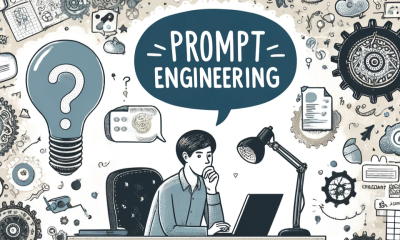Artificial Intelligence
Unveiling ChatGPT-4o: Next-Gen Features and Their Transformative Impact

The latest iteration of OpenAI's conversational model, ChatGPT-4o (“o” for “omni”) has arrived, bringing with it a host of new features that promise to revolutionize the way we interact with AI. Building on the success of its predecessors, GPT-4o introduces significant advancements in language understanding, contextual awareness, and user interaction capabilities. This article explores these new features in detail, highlighting how they can enhance the user experience and potential concerns with these new features.
Enhanced Language Understanding and Generation
One of the most notable improvements in GPT-4o is its enhanced language understanding and generation capabilities. The model has been trained on a more extensive and diverse dataset, allowing it to comprehend and generate text with greater accuracy and coherence. This improvement is particularly evident in complex conversations that require deep contextual understanding and nuanced responses.
Use Case: Customer Support
For businesses, this means that GPT-4o can handle customer inquiries more efficiently and effectively. The AI can understand customer concerns better, provide more accurate solutions, and handle follow-up questions with improved coherence. This leads to higher customer satisfaction and reduced workload for human support agents.
Concerns
Despite these advancements, there are concerns about over-reliance on AI for customer support. Customers may feel frustrated if they cannot reach a human representative when needed, especially for complex or sensitive issues. Additionally, while the AI's understanding has improved, it can still misinterpret context, leading to potentially incorrect or misleading responses.
Advanced Contextual Awareness
GPT-4o introduces advanced contextual awareness, enabling it to maintain context over longer conversations and understand the subtleties of human dialogue more effectively. This feature allows the model to keep track of previous interactions, recall relevant information, and provide more contextually appropriate responses.
Use Case: Personal Assistants
Th personal digital assistants enhancement allows GPT-4o to offer a more personalized experience. For example, it can remember user preferences, past interactions, and specific details such as upcoming appointments or favorite activities. This results in a more tailored and responsive assistant that can better anticipate user needs.
Concerns
While advanced contextual awareness is beneficial, there are privacy concerns regarding the amount of personal data the AI needs to retain. Users might be uncomfortable with the extent of information remembered by the assistant, raising questions about data security and the potential for misuse.
Improved Multimodal Capabilities
GPT-4o now supports improved multimodal capabilities, allowing it to process and generate content that includes not only text but also images and other media. This advancement makes the model more versatile and capable of engaging in more interactive and visually enriched conversations.
Use Case: Educational Tools
In educational settings, GPT-4o can enhance learning experiences by incorporating visual aids into explanations. For instance, when explaining a scientific concept, the AI can provide relevant diagrams or images to help students grasp complex ideas more easily. This multimodal approach can make learning more engaging and effective.
Concerns
The inclusion of multimodal capabilities raises issues about the potential for inappropriate or harmful content. Ensuring that the AI does not generate or distribute misleading or explicit images is critical. Additionally, there is a risk that reliance on AI-generated visuals might reduce critical thinking and creativity.
Customization and Fine-Tuning
Another significant feature of GPT-4o is its enhanced customization and fine-tuning capabilities. Users can now tailor the model to better suit specific applications or industries by adjusting its behavior, tone, and response style. This customization ensures that the AI aligns more closely with the unique requirements of different use cases.
Use Case: Content Creation
Content creators can leverage this feature to produce material that matches their brand's voice and style. Whether it's drafting, generating social media content, or assisting in scriptwriting, GPT-4o can be fine-tuned to deliver consistent and on-brand outputs, saving time and effort in the creative process.
Concerns
Customization brings the risk of bias being introduced into the AI's responses. If the model is fine-tuned with biased data, it may produce content that reflects those biases. Ensuring that customization processes include checks for fairness and objectivity is crucial to prevent misuse.
Real-Time Collaboration and Integration
GPT-4o introduces real-time collaboration features, allowing multiple users to interact with the AI simultaneously. This is particularly useful for team environments where collaboration and quick access to information are crucial. Additionally, the model boasts improved integration capabilities, making it easier to embed into various software and platforms.
Use Case: Project Management
In project management scenarios, teams can use GPT-4o to streamline workflows by integrating it into project management tools. The AI can assist in scheduling, task allocation, and progress tracking, all while providing real-time updates and insights. This integration facilitates smoother collaboration and enhances productivity.
Concerns
Real-time collaboration features can raise security and data integrity concerns. Unauthorized access or data breaches could compromise sensitive project information. There may also be challenges in ensuring that all team members use the AI appropriately and consistently.
Ethical Considerations and Safety Measures
With the release of GPT-4o, OpenAI has also placed a strong emphasis on ethical considerations and safety measures. The model includes robust mechanisms to minimize harmful outputs and ensure responsible usage. Enhanced moderation tools and stricter guidelines help prevent the dissemination of inappropriate or biased content.
Use Case: Mental Health Support
For mental health support applications, these safety measures are crucial. GPT-4o can provide empathetic and supportive interactions while adhering to ethical guidelines, ensuring that users receive appropriate and safe guidance. This can be particularly valuable in providing initial support and directing users to professional help when needed.
Concerns
Despite these measures, there is always the risk that the AI may generate inappropriate or harmful content. Ensuring comprehensive and effective moderation is a continuous challenge. Moreover, reliance on AI for mental health support should not replace professional human interaction, as the AI cannot fully understand the complexities of human emotions and mental health issues.
Conclusion
GPT-4o represents a significant leap forward in conversational AI, offering enhanced language understanding, contextual awareness, multimodal capabilities, and customization options. These new features open up a wide range of applications, from customer support and personal assistants to educational tools and content creation. With its improved real-time collaboration and ethical safeguards, GPT-4o is sure to transform how we interact with AI, making it a more powerful and reliable tool for various industries. However, it is essential to remain vigilant about the potential concerns and challenges associated with these advancements to ensure that the technology is used responsibly and ethically. As we continue to explore its potential, the future of AI-driven conversations looks incredibly promising.














